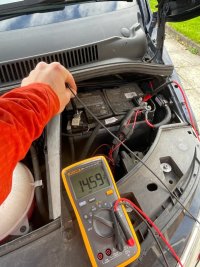Any help would be greatly appreciated with the below
Am just wondering if anyone has come across this issue before with a DC-DC charger. I first thought it was a faulty unit (CTEK 250SE) so changed to the RENOGY DCC50S but am still having the same issue.
When the wire from the alternator is not attached to the DC-DC charger it reads as it should (14V~ while running and 12~ while off) but as soon as I then connect this wire to the alternator input on either the CTEK or RENOGY unit the voltage drops to <10 even though the voltage at the starter battery itself stays 12V or 14V. This means that it never swaps over to charge the leisure battery.
There is a good ground connection from the starter battery to the DC-DC charger and everything else works as it should when on EHU.
Has anyone come across this before by any chance?
Am just wondering if anyone has come across this issue before with a DC-DC charger. I first thought it was a faulty unit (CTEK 250SE) so changed to the RENOGY DCC50S but am still having the same issue.
When the wire from the alternator is not attached to the DC-DC charger it reads as it should (14V~ while running and 12~ while off) but as soon as I then connect this wire to the alternator input on either the CTEK or RENOGY unit the voltage drops to <10 even though the voltage at the starter battery itself stays 12V or 14V. This means that it never swaps over to charge the leisure battery.
There is a good ground connection from the starter battery to the DC-DC charger and everything else works as it should when on EHU.
Has anyone come across this before by any chance?


